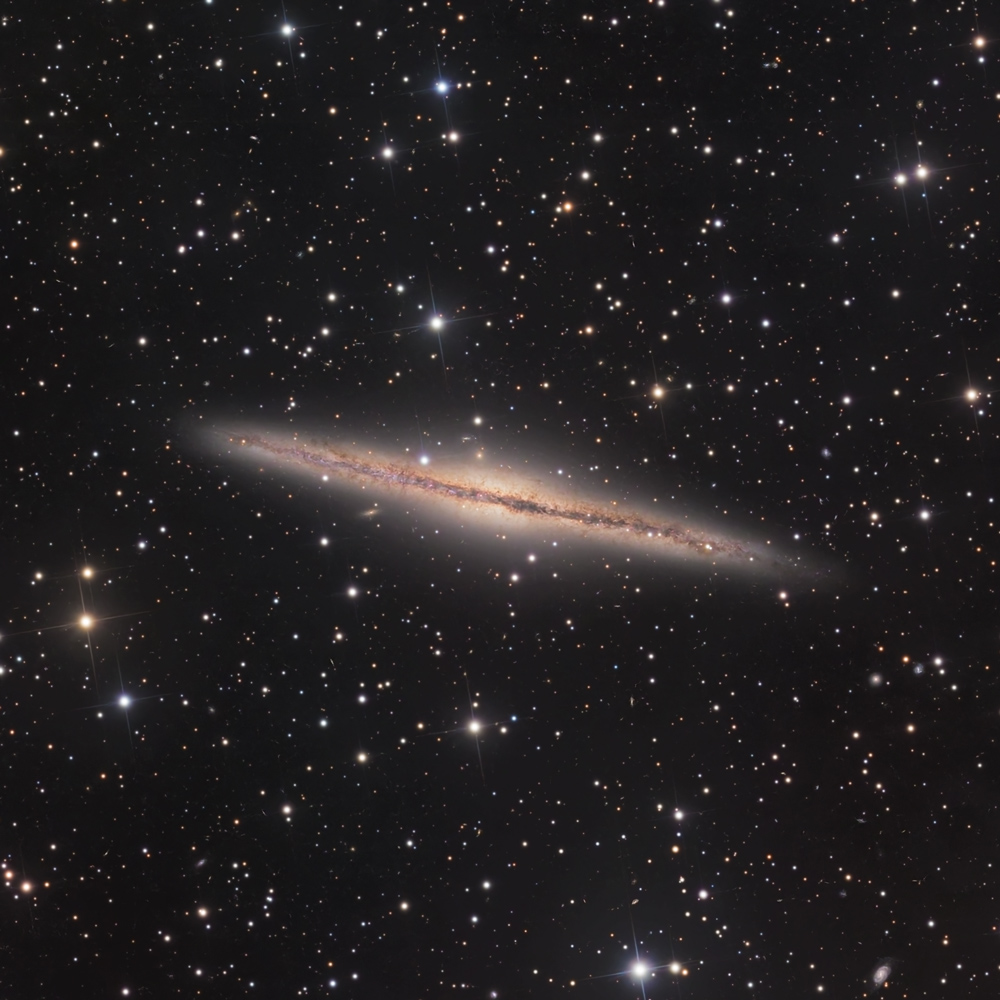

NGC 891 is a spiral galaxy visually located in the constellation Andromeda. It presents to
us edge-on. It is thought to be about 30 million light years away from us, which would give it a diameter of about 130,000 light years. In terms of light output, size and shape, NGC 891
and our Milky Way galaxy are very similar; looking into the heart of the Milky Way from the southern hemisphere of earth, at a very dark site, gives a view very similar to photographing
this galaxy from Earth. The entire field of the uncropped versions is about the angular size of a full moon. Technical Information: Ha:L:R:G:B: 380:810:240:120:240 (a total of almost 30 hours of light-frame exposure time); there are fifty 15-minute exposures and 20 3-minute exposures through the
luminance filter; red and green exposures were all 15-minute exposures; blue were all 20-minute exposures, while Ha were all 20-minute exosures. The luminance layer consisted of an HDR blend
of the 15-minute and 3-minute exposures, with the Ha data blended in; the red channel is a combination of sixteen 15-minute images thorugh a red filter and the Ha data. The green channel is
a combination of eight 15-minute images through the green filter. The blue channel is a combination of twelve 20-minute images through a blue filter. Equipment: RC Optical Systems 14.5 inch Ritchey-Chretien carbon fiber truss telescope, with ion-milled optics and RCOS field flattener, at about f/9, and an SBIG STX-16803 camera with
internal filter wheel (SBIG filter set), guided by an SBIG AO-X, all riding on a Bisque Paramount ME German Equatorial Mount. Image Acquisition/Camera Control: Maxim DL, controlled with ACP Expert/Scheduler, working in concert with TheSky X. Processing: All images calibrated (darks, bias and sky flats), aligned, combined and cropped in Pixinsight. Color combine in Pixinsight. Some finish work (background neutralization,
color calibration, NB blend, NoiseXTerminator and BlurXTerminator) done in Pixinsight; some cleanup finish work was done in Photoshop 2024. Location: Data acquired remotely from Sierra Remote Observatories, Auberry, California, USA. Date: Images taken on many nights in December of 2024. Image posted May 13, 2025. Date: Image scale of full-resolution image: 0.56 arcseconds per pixel. Seeing: Generally good. CCD Chip temperature: -25C Copyright 2024, 2025
Mark de Regt
As is often the case with large-field deep-sky photographs, there are a lot of tiny (meaning, of course, very far away) galaxies in the background of this photo; they're very evident in
the full resolution version, with many of them large enough to show significant structure.
I last imaged this striking galaxy 22 years earlier. To see what a combination of better equipment, better skies, better software, and better skills does, click here